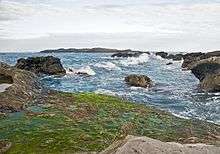Viridiplantae
| Viridiplantae | |
|---|---|
 | |
| An assortment of thallophyte Viridiplantae in a rock pool, Taiwan | |
| Scientific classification | |
| Domain: | Eukaryota |
| (unranked): | Archaeplastida |
| (unranked): | Viridiplantae Cavalier-Smith, 1981[1] |
| Subgroups | |
| Synonyms | |
Viridiplantae (literally "green plants")[1] are a clade of eukaryotic organisms made up of the green algae, which are primarily aquatic, and the land plants (embryophytes), which emerged within them.[6][7][8] Green algae traditionally excludes the land plants, rendering them a paraphyletic group. They have cells with cellulose in their cell walls, and primary chloroplasts derived from endosymbiosis with cyanobacteria that contain chlorophylls a and b and lack phycobilins. More than 350,000 species of Viridiplantae exist.[9]
In some classification systems, the group has been treated as a kingdom,[10] under various names, e.g. Viridiplantae, Chlorobionta, or simply Plantae, the latter expanding the traditional plant kingdom to include the green algae. Adl et al., who produced a classification for all eukaryotes in 2005, introduced the name Chloroplastida for this group, reflecting the group having primary chloroplasts with green chlorophyll. They rejected the name Viridiplantae on the grounds that some of the species are not plants, as understood traditionally.[11] The Viridiplantae are made up of two clades: Chlorophyta and Streptophyta.[12] Together with Rhodophyta and glaucophytes, Viridiplantae are thought to belong to a larger clade called Archaeplastida or Primoplantae.
A taxonomic evaluation of eukaryotes based on myosin distribution showed the Viridiplantae lost class-I myosins.[13]
Phylogeny and classification
Leliaert et al. 2012
Simplified phylogeny of the Viridiplantae, according to Leliaert et al. 2012.[14]
- Viridiplantae
-
- core chlorophytes
-
- Cladophorales
- Dasycladales
- Bryopsidales
- Trentepohliales
- Ulvales-Ulotrichales
- Oltmannsiellopsidales
- prasinophytes (paraphyletic)
- Pyramimonadales
- Mamiellophyceae
- Pycnococcaceae
- Nephroselmidophyceae
- Prasinococcales
- Palmophyllales
Cladogram
| ||||||||||||||||||||||||||||||||||||||||||||||||||||||||||||||||||||||||||||||||||||||||||||||||||||||||||||
| Cladogram following Leliaert et al. (2012), Figure 3 |
References
| Wikispecies has information related to: Viridiplantae |
- 1 2 T. Cavalier-Smith (1981). "Eukaryote Kingdoms: Seven or Nine?". BioSystems. 14 (3–4): 461–481. doi:10.1016/0303-2647(81)90050-2. PMID 7337818.
- ↑ Copeland, H.F. (1938). The kingdoms of organisms. Quart. Rev. Biol. 13, 383-420.
- ↑ Copeland, H. F. (1956). The Classification of Lower Organisms. Palo Alto: Pacific Books, p. 6, .
- ↑ Whittaker, R. H. (1969). New concepts of kingdoms or organisms. Science 163 (3863): 150–160.
- ↑ van den Hoek, C. & Jahns, H. M. (1978). Algen. Einführung in die Phykologie. Georg Thieme Verlag, Stuttgart.
- ↑ Cocquyt E, Verbruggen H, Leliaert F, Zechman FW, Sabbe K, De Clerck O (2009). "Gain and loss of elongation factor genes in green algae". BMC Evol. Biol. 9: 39. doi:10.1186/1471-2148-9-39. PMC 2652445
 . PMID 19216746.
. PMID 19216746. - ↑ Becker B (2007). "Function and evolution of the vacuolar compartment in green algae and land plants (Viridiplantae)". Int. Rev. Cytol. International Review of Cytology. 264: 1–24. doi:10.1016/S0074-7696(07)64001-7. ISBN 9780123742636. PMID 17964920.
- ↑ Kim E, Graham LE (2008). Redfield, Rosemary Jeanne, ed. "EEF2 analysis challenges the monophyly of Archaeplastida and Chromalveolata". PLoS ONE. 3 (7): e2621. doi:10.1371/journal.pone.0002621. PMC 2440802
 . PMID 18612431.
. PMID 18612431. - ↑ Smith SA, Beaulieu JM, Donoghue MJ (2009). "Mega-phylogeny approach for comparative biology: an alternative to supertree and supermatrix approaches". BMC Evol. Biol. 9: 37. doi:10.1186/1471-2148-9-37. PMC 2645364
 . PMID 19210768.
. PMID 19210768. - ↑ "Viridiplantae". Retrieved 2009-03-08.
- ↑ Adl, Sina M.; et al. (2005), "The New Higher Level Classification of Eukaryotes with Emphasis on the Taxonomy of Protists", Journal of Eukaryotic Microbiology, 52 (5): 399, doi:10.1111/j.1550-7408.2005.00053.x
- ↑ Simon A, Glöckner G, Felder M, Melkonian M, Becker B (2006). "EST analysis of the scaly green flagellate Mesostigma viride (Streptophyta): implications for the evolution of green plants (Viridiplantae)". BMC Plant Biol. 6: 2. doi:10.1186/1471-2229-6-2. PMC 1413533
 . PMID 16476162.
. PMID 16476162. - ↑ Odronitz F, Kollmar M (2007). "Drawing the tree of eukaryotic life based on the analysis of 2,269 manually annotated myosins from 328 species". Genome Biol. 8 (9): R196. doi:10.1186/gb-2007-8-9-r196. PMC 2375034
 . PMID 17877792.
. PMID 17877792. - ↑ Leliaert, F., Smith, D.R., Moreau, H., Herron, M.D., Verbruggen, H., Delwiche, C.F. & De Clerck, O. (2012). "Phylogeny and molecular evolution of the green algae" (PDF). Critical Reviews in Plant Sciences. 31: 1–46. doi:10.1080/07352689.2011.615705.
- ↑ Marin, B (2012). "Nested in the Chlorellales or Independent Class? Phylogeny and Classification of the Pedinophyceae (Viridiplantae) Revealed by Molecular Phylogenetic Analyses of Complete Nuclear and Plastid-encoded rRNA Operons". Protist. 163: 778–805. doi:10.1016/j.protis.2011.11.004.